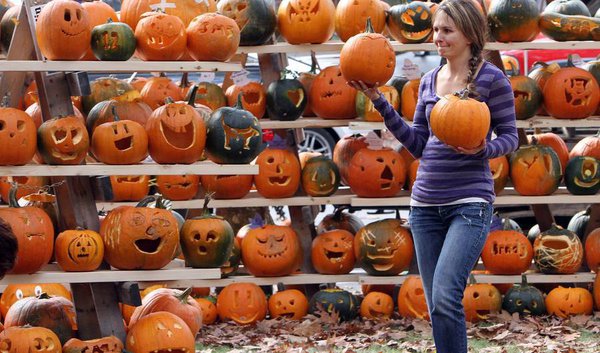Hallowe'en: A European or an American Festivity?
Hallowe'en, the Day of the Witches, All Hallows' Evening, Samhain. Day of the Dead. Pumpkins, chestnuts, new wine, mulled wine. A bonfire, to keep away the evil spirits, the Aos Sí and to bring the community together, the first festival of light in the dark winter with little or no agricultural produce. What is the meaning of all these symbols?

The end, or death, of the agricultural year in Europe happens around this time and as the centuries wore on, the Celtic peoples (and probably others) stipulated that at sunset on October 31 begins Samhain (pronounced So'win). This was a "boundary time" when the Aos Sí (bad spirits) could move easily from the underworld into our world and so bonfires were lit to cleanse the Earth from evil and to protect communities against it.
From the earliest times, children would go "mumming" or "guising", wearing disguises as monsters, witches or bad spirits, going from door to door asking for offerings of food and drink - or else people placed these outside their homes for the Aos Sí to take and be appeased.
A time of darkness and uncertainty
It was a time of darkness and uncertainty, a time when survival depended on how much food had been stored from the harvest and in what conditions it was in, a time when the wine or beer barrel was opened and which hopefully would last until Spring. It was a time when the fattened pig would be slaughtered and salted, when sausages would be made, hams smoked.
It was a time before the potato, which was brought to Europe from the region of the Andes in the sixteenth century. What substituted the potato at the time was the chestnut, especially in Southern Europe, where a chestnut festivity took place at the beginning of November around a Magnus Ustus, a Great Bonfire. As with Samhain, the date became institutionalized and was fixed on November 11, the Day of Saint Martin.
Medieval festivals carried across the waters
In Medieval times, these festivities were still very popular in Europe and were carried over to the Americas by the Portuguese (Brazil), Spanish (rest of Latin America), French and British (North America), where they continued, while they became less popular in Europe and were celebrated locally by communities. In some cases, they took on a different meaning, as was the case with Guy Fawkes' Night, or Bonfire Night, in the United Kingdom.
Guy Fawkes, an English Catholic, was part of a plot to blow up barrels of gunpowder under the House of Parliament when it was to be opened by King James VI of Scotland, James I of England (who became King of both countries upon the death of Queen Elizabeth I in 1603), on November 5, 1605. The plot was discovered, Guy Fawkes committed suicide just before he was hanged (he jumped from the gallows and broke his neck) and since then the day has been remembered throughout the UK with fireworks, bonfires, chestnuts and a stuffed doll representing the "Guy", children wheeling the doll around the villages asking for "A penny for the Guy".
But this does not begin in 1605 - as we see, the symbology is the same as that coming from ancient times and the burning of the guy resembles the burning of the scarecrow in Iberian communities around this time.
Lost traditions, but traditions with meaning, traditions and festivities which bring people together, instead of dividing them, festivities of sharing, and not stealing, festivities for the common good, to see who is needy, and festivities which provide a self-regulatory mechanism for communities based upon human warmth.
Perhaps we can learn something from history. Maybe we should research our traditions and festivals instead of relegating them to history's trash can.
Timothy Bancroft-Hinchey
Pravda.Ru
*Timothy Bancroft-Hinchey has worked as a correspondent, journalist, deputy editor, editor, chief editor, director, project manager, executive director, partner and owner of printed and online daily, weekly, monthly and yearly publications, TV stations and media groups printed, aired and distributed in Angola, Brazil, Cape Verde, East Timor, Guinea-Bissau, Portugal, Mozambique and São Tomé and Principe Isles; the Russian Foreign Ministry publication Dialog and the Cuban Foreign Ministry Official Publications. He has spent the last two decades in humanitarian projects, connecting communities, working to document and catalog disappearing languages, cultures, traditions, working to network with the LGBT communities helping to set up shelters for abused or frightened victims and as Media Partner with UN Women, working to foster the UN Women project to fight against gender violence and to strive for an end to sexism, racism and homophobia. A Vegan, he is also a Media Partner of Humane Society International, fighting for animal rights. He is Director and Chief Editor of the Portuguese version of Pravda.Ru.
Subscribe to Pravda.Ru Telegram channel, Facebook, RSS!

